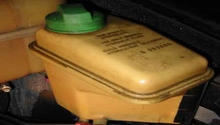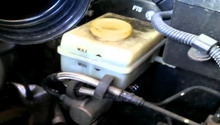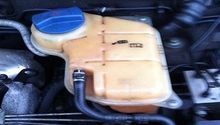Audi A3: How to Change Power Steering Fluid
Yes, power steering fluid is also an oil, and requires service like an engine or gear oil!
This article applies to the Audi A3 (2004-2012).
One of the more popular maintenance items to overlook is the inspection and flushing of your power steering system. Probably the biggest reasons for this is that it is a sealed system, and the manual may even tell you that it is a lifetime fluid that never needs changing because it is, in fact, a sealed system. Regardless of that fact, the steering rack and system has moving parts that get hot and the friction, heat and constant circulation of your power steering fluid is going to make it so that it will eventually break down and need replacing. Luckily, this is one of the most simple procedures you can do to your Audi. Unfortunately, the pros don't want you to know that in order to continue charging you a ransom to do it for you. Don't let them. Give your self a few minutes on a lazy morning and take care of this yourself. When you are finished, call up several pros and get a quote for this service and then break out into your happy dance.

Materials Needed
- 5mm Allen wrench
- Socket set and ratchet
- Pliers
- Line clamp
- Zip ties
- Catch bottle or container
- 2 quarts of replacement power steering fluid
- Hydraulic floor jack
- Jack stands
Step 1 – Jack up the front end of your car
You need to get your front end up in the air safely and placed on jack stands. Consult the owner's manual and make sure you are following their guidelines for the proper jack point locations. Audi suggests their special mushroom type jack plate adapters as well. You can use a block of wood as indicated in the figure below to jack it up, then place on jack stands. Never work under your car without having jack stands in place and the wheels chocked. Make sure that you can turn your steering wheel from left to right full lock to full lock.
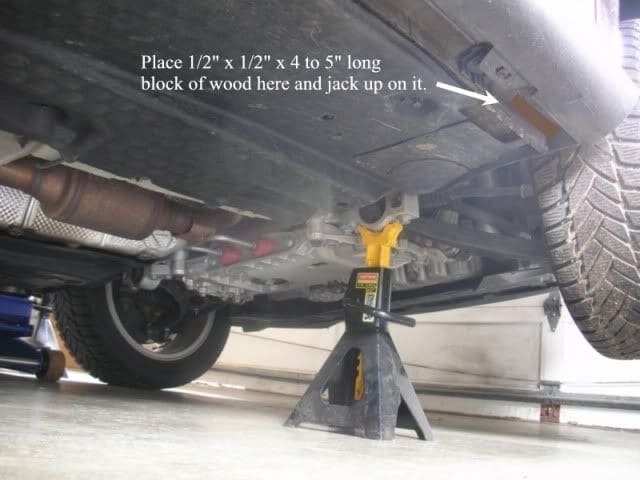
Step 2 – Remove engine skid plate (optional)
If you want to take the time to remove the skid plate (belly pan), do that first. The only reason to remove it is to help facilitate the routing of the hose or tubing that you are using to drain the power steering fluid into your catch container. You can probably work around this obstruction, but the few minutes it takes to remove the skid plate is worth the trouble. Ready your 8mm socket.

Step 3 – Disconnect the power steering fluid reservoir
We need to disconnect and move the reservoir into a position to allow us to work. This is a sealed system, and although it shouldn't leak, we need to take some precautions, mainly to avoid contamination.
- Remove the 5mm Allen head bolt that mounts the reservoir in place. There are now only two hoses or lines keeping it in place.
- Use a soft-tipped hose clamp, or another spring-tensioned clamp that won't damage the return line, and clamp the return line shut behind the installed hose clamp on the backside of the reservoir.
- Use a pair of pliers to squeeze the installed hose clamp on this line so it opens up. Move this clamp back towards the large line clamp you just hooked on to the return line.
- Pull off the return line from the reservoir nipple.
- Turn the reservoir so that the nipple is now facing upwards, and set the reservoir aside.
- Use a piece of tape or plastic baggie, or something to cover that nipple, so nothing gets into the reservoir and contaminates the system.

Step 4 – Connect a drainage hose to the return line
We now will attach a hose or tube to the return line. It has to be sufficiently long enough to snake through the engine bay and down into your catch container. Your car takes about one liter of power steering fluid, so your catch container needs to be at least of that size to capture it all. Your drain hose can be large diameter aquarium tubing, or even a bicycle inner tube, which works well because it is pliable.
- Connect one end of your tube to the end of the return line and use a zip tie to secure it in place.
- Feed your hose or tube down through the engine bay and into your container (hence, the removal of the skid plate).
- Make sure the end of your hose is secured into the container, and it won't get knocked over and spilled.

Step 5 – Start flushing
With your system all connected, you can start flushing the fluid out. This is a very similar process to bleeding the brake system; whereas you need to use the reservoir, but you need to make sure that you never let air into the system.
- Place your reservoir back into position with the fill cap pointing up. Make sure it is pretty level.
- Remove the cap and fill the reservoir all the way to the top. Do not worry about the cold and hot levels, we will worry about that later. The reservoir needs to be completely filled and you never want to let it get empty through this process, or you'll introduce air into the system and that is bad.
- Turn your steering wheel all the way to one side, left for example, and then all the way back to the right. This is full lock to full lock. Do this about three times and it will suck a considerable amount of fluid through the reservoir and out the return line into your catch container. Three times is about all you'll get from a full reservoir.
- Re-fill your reservoir all the way to the top again.
- Repeat the previous step, turning the wheel back and forth three times again.
- Check the reservoir and refill it to the top again.
- After the second round, check your catch container. You should see your old stuff in there. You will repeat this process until the new stuff starts flowing.
- Repeat as many time as it takes until you see the new fluid flowing completely through the system and start going into your catch container. You may end up using 1.5 liters.
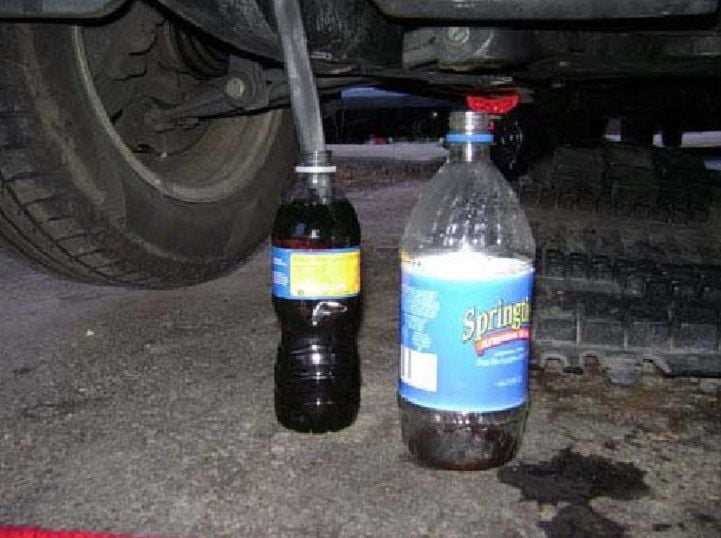
Step 6 – Finish her off
Once you have pumped all the old stuff out, do not re-fill the reservoir. You want it low but not empty. We need to get it reconnected and installed back together again first.
- Replace the cap on the reservoir.
- Cut the zip tie and pull off your drain hose or tubing.
- Push the return line back onto the nipple as far as it will go.
- Use your pliers to move the original hose clamp back into position, then make sure that it is nice and tight.
- Remove the line clamp.
- Reinstall the reservoir and tighten the 5mm Allen head bolt.
- Reinstall the skid plate or belly pan if you removed it.
- Open the cap to your resevoir and fill it up to the COLD fill line only. Do not over-fill.
- Start her up and turn the steering wheel from full lock to full lock, then shut her down.
- Check the fluid level in the reservoir again and add more if needed.
- Take her for a test ride and check the fluid level again, making sure that it is hitting the warm level now that the engine is warmed up.
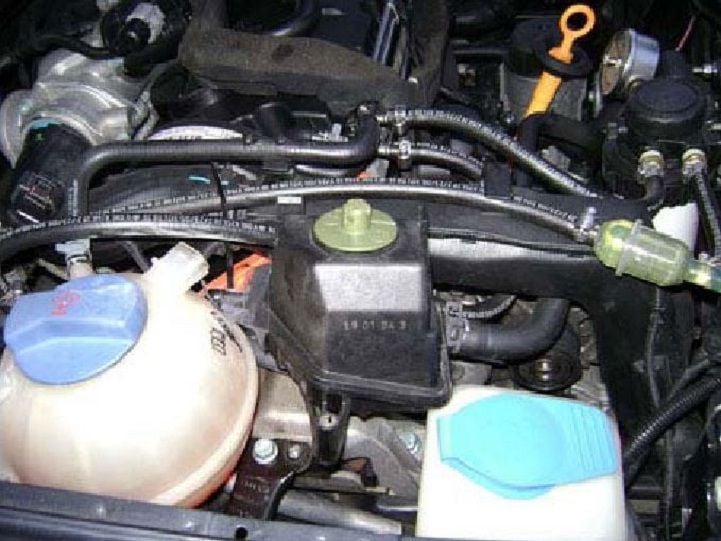
Related Discussions and Sites
- Want to Flush Your Power Steering Fluid? - AudiWorld.com
- How to Bleed Power Steering - AudiWorld.com
- Power Steering Flush Procedure - TDIclub.com
- Power Steering Fluid Confusion - AudiWorld.com
- How to Change Audi Power Steering Fluid - BlauParts.com

